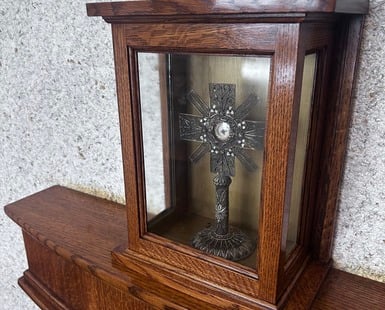The Cross Is Personal
-
 In the parish’s Our Lady of Sorrows Adoration Chapel, you will find peace and solitude when spending time with our Lord as he rests in the monstrance. But what you may not realize is that a first-class relic of the instrument used to crucify Him is nearby. A relic of the True Cross was bequeathed by an IHM parishioner about 15 years ago. It now sits in a reliquary in a glass box to the right of the monstrance, a reminder of the victory over sin and death.
In the parish’s Our Lady of Sorrows Adoration Chapel, you will find peace and solitude when spending time with our Lord as he rests in the monstrance. But what you may not realize is that a first-class relic of the instrument used to crucify Him is nearby. A relic of the True Cross was bequeathed by an IHM parishioner about 15 years ago. It now sits in a reliquary in a glass box to the right of the monstrance, a reminder of the victory over sin and death.
September 14th is the feast day of the Exaltation of the Holy Cross. This is the day the Church celebrates both the discovery and the recovery of the True Cross of Jesus Christ. The Church also celebrates the dedication anniversary of the Church of the Holy Sepulcher which sits above the empty tomb of Jesus. Early in the fourth century, Saint Helena, mother of the Roman Emperor Constantine, went to Jerusalem in search of the holy places of Christ’s life. During an excavation of a temple built over the Savior’s tomb, workers found three crosses. According to the historian Rufinus, the identity of the True Cross was confirmed by a miraculous healing.
Today the cross is the universal image of Christian belief. But what does it mean to you personally?
First, the cross is a sign of God’s love. John 3:16, which we heard in the Gospel, is perhaps the most famous verse in all of Scripture: “God so loved the world that He gave His only Son.” We must never forget that love is at the heart of the cross. Jesus was not forced to die. He chose to lay down His life, to suffer, to be lifted up—because He loves us.
Second, the cross is a call to humility and obedience. St. Paul reminds us Christ “did not regard equality with God something to be grasped.” Instead, He emptied Himself. The path to exaltation, for Christ and for us, passes through humility. In a world that prizes power, pride, and self-promotion, the cross teaches us that true greatness is found in self-giving love. To follow Jesus means to carry our own crosses—to say “yes” to God’s will even when it’s difficult, to love even when it costs us.
Third, the cross is a source of healing. Just as the Israelites were healed by looking upon the bronze serpent, we are healed by looking upon Christ crucified. When we bring our wounds, our sins, our failures to the foot of the cross, we do not encounter condemnation—we encounter mercy. The cross tells us that no sin is too great, no wound too deep, that the love of Christ cannot redeem it.
And finally, the cross is a sign of victory. We know how the story ends. The cross leads to the Resurrection. Death does not have the final word—life does. Evil does not triumph—God does. And that means that in our own lives, when we face suffering, discouragement, or trials, we can cling to the cross. It reminds us that God is with us, that He is working even through our pain, and that victory is already won.
